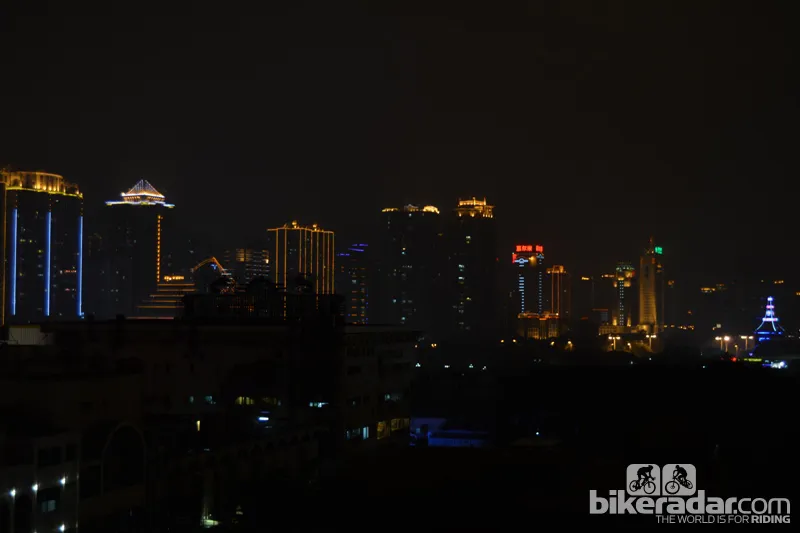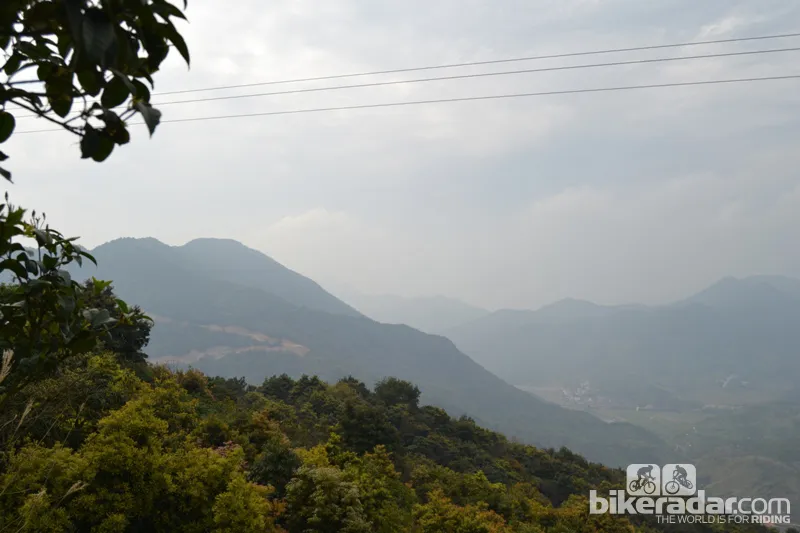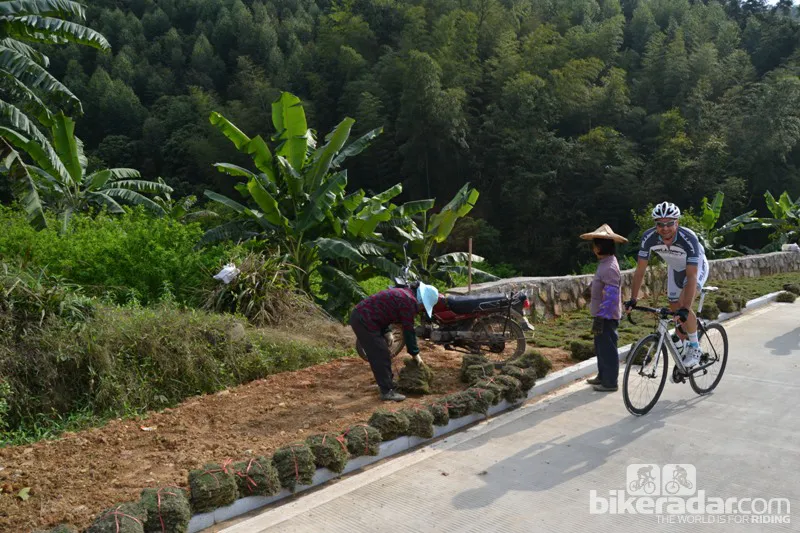Recently, we visited China and Taiwan for the Taipei Cycle Show and an exclusive look inside a Chinese bike factory. While there we got a taste of what it’s like to ride around Xiamen. A huge number of high-end bike brands now manufacture in the city, including Specialized, De Rosa, Eddy Merckx, Cube, Cannondale and Fondriest.
Cycling’s heartland used to be northern Italy. Artisan bike-builders hand-crafted exquisite frames to be ridden through the rolling hills of Tuscany and the steeps of the Dolomites. The area remains one of the most popular destinations for cycling holidays but the industry has virtually all shifted to the Far East.
The terrain and climate bear uncanny similarity to northern Italy. Xiamen is on an island that’s linked to the mainland. Once you get inland, rolling hills and medium mountains await. Our host and guide was Mark Blewett, an ex-pro and the founder of Swift Carbon, the first non-Chinese brand to do its product development in China, so he knows the roads well.
Xiamen is a booming city that’s dripping in new money. It looks more like Hong Kong or Dubai. The factories have been moved out of town as it becomes more of a commercial and vacation centre. There are dozens of new skyscrapers and fancy hotels, a motor yacht park with $5m waterfront houses, clean beaches with a theme park and big new roads to link it all together.

There are two extremes to cycling in China, from functional three-wheelers to super bikes
But it only takes one random turn off the main road to see that much of it is window dressing. Behind rows of tall planted trees is the other side of China, which remains very poor. A muddy, potholed road passes through clusters of small buildings with electricity cables running low overhead, clothes lines strung across the street and plastic garden furniture visible in the front room of one house – there’s no wall. The scenes provide some harsh perspective.
On a clear day you can see Taiwan from the coast. China and Taiwan are inextricably linked and their differences not so old as to be forgotten. Xiamen has a huge sign facing across the water that says ‘Two countries, one system’, essentially a declaration of friendship. Taiwan also has a sign, visible from Xiamen with binoculars, which says ‘Two countries, two systems’. Direct flights between the two places only began in the last two years, and there are many big military bases in the hills around Xiamen. Despite that, China and Taiwan are trade partners on a massive scale.
Rules of the road
Our first ride is an 80km loop around the island, starting from the hotel on four-lane roads. The traffic requires concentration but there’s no aggression and it rolls along steadily. Thanks to the smooth new asphalt, and the ex-pro setting the pace, we’re often travelling as fast as the cars. Nobody seems to mind.
The biggest hazards are the pedestrians, who step out and always look the wrong way, and drivers drifting from one lane to the other regardless of whether there’s another vehicle next to them. ‘Give way’ is a twisted concept here – the law says anyone turning out of a side road has right of way. Nevertheless, it never feels any more dangerous than cycling in a UK city in rush hour.
A tough climb at 8-15 percent takes us around the Shangli reservoir and a private golf course, to just over 200m. From there, a concrete side road winds down into another valley. Part of the way down, Mark brakes hard, calls out, “Low gear, now” and turns sharp left onto a cobbled climb with a surface that’s more like crazy paving. It’s seriously steep and incredibly bumpy. We haul ourselves to the top, where Mark tells us it’s the first time he’s ridden all the way up. He doubts anyone has ever gone up it on a road bike before. Bizarrely, there’s a driving school at the top, on a large expanse of flat concrete that reeks of ex-military. And before we descend, a police car trundles past. It wouldn’t be remarkable were it not the only one we see on the whole trip. We’d half expected tanks on the streets.

By this point it was hurting too much for us to enjoy the hazy view
Later on we pass Dongshan reservoir, with its busy beaches and congested access road. It’s Sunday and not raining, so the locals are out for family picnics. Mark leads us up another steep side road that’s cut short by a military check point and a thick yellow line across the road. The soldiers see us approaching and start towards us as we get within a few metres of the line. They stop when we do but don’t wave back. There may not be the same political tensions as 20 years ago but the roadside sign saying ‘Guard Against Spies’ is only faded, not removed.
Experience rural China
On the other side of the island we stop in at Swift Carbon’s head office for a snack and to cut down the seat tube on one of the bikes, a pre-production prototype Ultravox, so that someone else can ride it. Then we realise we’re running out of daylight so we set off on the main coast road, the sea just 50m to our left. Mark pulls us along in a pace line at 40-45kph, tucked down on the drops, overtaking as many puzzled drivers as are overtaking us on this three-lane carriageway.
The city centre skyscrapers, brightly lit and marking the end of our ride, grow taller in front of us and more crisply picked out against the sky as night replaces day. Two hours ago we were riding a deserted cobbled climb, now we're riding hard on the flat and craning our necks to take in a skyline the likes of which simply doesn't exist in Europe. We’re still 20km from Xiamen centre, we've got half a bidon of water, it's dark and we're wearing sunglasses. By the time we reach the hotel we’re grinning from the most surreal end to a ride we’ve ever had.

The Xiamen skyline was a spectacular finale to our ride around the island
To ride in real Chinese countryside you need to drive to the edge of Xiamen. That’s what we do on our second day, past the sprawling production zones – Apple’s factory is the size of a small town itself. It seems the city has spread almost as far as it can because the mountains are already visible through the haze and we get barely 5km before hitting the Blue Mountain Road, at which point the densely forested hills prevent any further concrete encroachment.
The climb is cat 2, averaging 8.5 percent for 5.2km but 12 percent for the middle 3km, which is packed with 11 hairpins. On a 39x25 gear, and with some friendly competition going on, it’s 23 minutes of pain. A compact, or at least a 27t sprocket, is highly recommended if you visit, though there are flatter routes to choose. From the top there’s a hazy view back over Xiamen and a much clearer one over the hills that stretch into the distance inland. With 600m peaks cloaked in dark green and with lakes at their feet, it could almost be Lombardy.
Down the other side, in the valley, we pass duck and rice farms with a handful of people working the fields. About 100m away, two water buffalo graze. If this were a package holiday, the most cynical might suspect that all this iconography had be staged, but this is authentic China. The villages we ride through are small and made up of plain, boxy buildings. There’s hardly a person in sight but miniature Chinese foo dogs trot across the traffic-free roads, alert and purposeful, simultaneously appearing both stray and pedigree. They could be a metaphor for the whole country.
Going further afield
Mark has ridden in several regions of China and says that Beijing and Hangzhou, both hosts of new UCI WorldTour races, also offer lots of great riding. However, he adds, “The traffic and pollution get really bad so either set off at 5am or drive to the edge of the city to start your ride. The best idea is to visit as part of an organised trip with a back-up vehicle, or at least with someone who knows the roads and the country.
“Another amazing area for riding is Yunnan, on the Tibetan border. The air is clean and the roads and scenery are amazing. You can go down a valley road and off to the left and the right are countless Alpe d’Huez-type climbs, one after another.”
We expect that the vast majority of cyclists will still flock to Italy and Majorca, and they’re right to do so. But if you want a truly different cycling experience, China is worth considering. And if you’re travelling to the country on business, you should definitely take your bike.

The sort of architecture you can expect to see while riding in China
Cost of travel and accommodation
Flights from the UK to Xiamen start at under £700 but are nearer £1,000 for the fastest (15hr) route with a stop in Hong Kong. Flights to Xiamen via Hong Kong cost from £1,670 (US$2,584) from New York, and from £1,094 (US $1,692) from Los Angeles. To fly from Melbourne to Xiamen costs from £944 (AUS$1,472).
Accommodation in Xiamen starts at under £30 per night for an adequate two-star hotel. The city also has a large number of high-standard business hotels and several seaside resort hotels, with prices from £140 night.












